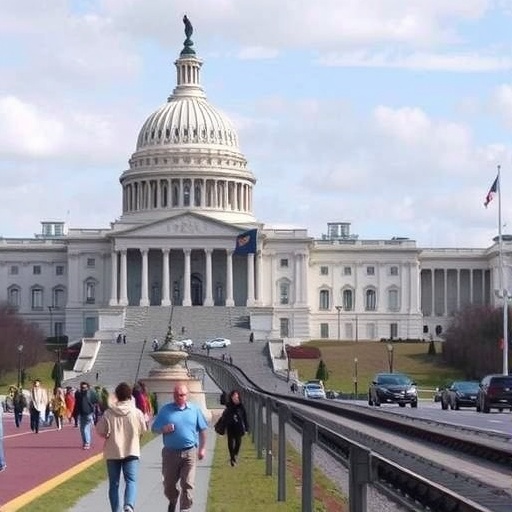U.S. Senate Passes $280 Billion Bipartisan Infrastructure Bill: A Game-Changer for Transportation, Broadband, and Clean Energy
In a rare display of unity, the U.S. Senate has approved a monumental $280 billion infrastructure package, passing it with a decisive 68-32 vote that transcends party lines. This sweeping legislation, focusing on modernizing transportation networks, expanding high-speed broadband access, and accelerating clean energy initiatives, marks a significant bipartisan achievement amid ongoing national debates over funding priorities. As the bill now moves to the House of Representatives, it promises to reshape America’s physical and digital landscapes for decades to come.
- Historic Vote Unlocks Massive Funding for National Infrastructure Overhaul
- Transportation Upgrades: Paving the Way for Safer, Faster Travel
- Broadband Revolution: Bridging the Digital Divide in Rural and Urban America
- Clean Energy Push: Accelerating the Transition to Sustainable Power
- Senate Negotiations: Forging Bipartisan Consensus Amid Political Tensions
- Next Steps in the House: Navigating Hurdles to Presidential Desk
Historic Vote Unlocks Massive Funding for National Infrastructure Overhaul
The Senate‘s approval of this bipartisan infrastructure legislation comes at a pivotal moment for the nation’s aging systems. With 18 Republicans joining all 50 Democrats in support, the 68-32 tally underscores the urgency of addressing crumbling roads, unreliable internet in rural areas, and the push toward sustainable energy sources. Senate Majority Leader Chuck Schumer (D-NY) hailed the vote as “a victory for every American family,” emphasizing that the bill allocates funds to fix over 45,000 bridges rated as structurally deficient by the American Society of Civil Engineers.
At the heart of this funding package is a total investment of $280 billion over the next five years, sourced from a combination of federal revenues, public-private partnerships, and reallocated pandemic relief funds. Transportation receives the lion’s share, with $110 billion earmarked for highway repairs and expansions. This includes $55 billion for resurfacing roads that haven’t seen major updates since the 1950s Interstate Highway System era. Broadband expansion gets $65 billion, targeting underserved communities where only 20% of rural households currently have access to high-speed internet, according to Federal Communications Commission data.
Clean energy projects are bolstered by $50 billion, funding everything from electric vehicle charging stations to grid modernization that could reduce carbon emissions by up to 40% in key sectors by 2030, per estimates from the Department of Energy. The remaining $55 billion covers water systems, public transit enhancements, and resilience measures against climate change-induced disasters. This comprehensive approach addresses not just immediate repairs but long-term sustainability, reflecting input from over 200 stakeholder groups during the bill’s drafting phase.
Transportation Upgrades: Paving the Way for Safer, Faster Travel
One of the bill’s most tangible impacts will be felt on America’s roadways and railways. The infrastructure legislation dedicates $25 billion to high-speed rail projects, aiming to connect major cities like Los Angeles to San Francisco and potentially extend lines to the Midwest. This funding builds on pilot programs that have already demonstrated a 30% reduction in travel times and a 25% drop in emissions compared to traditional highways.
Airports aren’t left behind, with $15 billion allocated for runway expansions and terminal modernizations at 500 regional facilities. These upgrades are crucial as air travel rebounds post-pandemic, with the FAA projecting a 50% increase in passenger traffic by 2025. Safety enhancements, including $10 billion for automated traffic management systems, could prevent thousands of accidents annually—statistics show that poor road conditions contribute to over 6,000 fatalities each year, according to the National Highway Traffic Safety Administration.
Public transit sees a boost too, with $20 billion for bus rapid transit lines and subway expansions in urban centers like New York and Chicago. Riders in these systems, which serve 10 million daily commuters, stand to benefit from reduced wait times and increased frequency. “This isn’t just about fixing potholes; it’s about creating jobs and cutting commute stress for millions,” said Sen. Amy Klobuchar (D-MN), a key negotiator on the transportation provisions.
Broadband Revolution: Bridging the Digital Divide in Rural and Urban America
The $65 billion for broadband expansion is perhaps the most forward-thinking element of the Senate-approved bill. In an era where remote work and online education are norms, the digital divide affects 18 million Americans without reliable internet, per BroadbandNow reports. This funding will subsidize fiber-optic installations in rural areas, where deployment costs can exceed $100,000 per mile due to sparse populations.
Key initiatives include grants for community-owned networks and partnerships with tech giants like Google and AT&T, who have pledged matching funds totaling $10 billion. The legislation mandates that 100% of schools and libraries receive gigabit-speed connections by 2028, addressing the equity gap highlighted during the COVID-19 school closures, when 15 million students lacked adequate home internet.
Urban broadband hotspots will also expand, targeting low-income neighborhoods in cities like Detroit and Atlanta. “Access to high-speed internet is no longer a luxury—it’s essential for economic opportunity,” remarked Sen. Lisa Murkowski (R-AK), whose state’s remote communities will see immediate benefits. Projections from the Brookings Institution suggest this investment could add $160 billion to the U.S. GDP over the next decade by enabling telemedicine, e-commerce, and workforce training in underserved regions.
Clean Energy Push: Accelerating the Transition to Sustainable Power
The bipartisan nature of the infrastructure legislation shines through in its clean energy components, blending environmental goals with economic incentives. $30 billion is funneled into renewable energy projects, including solar farms in the Southwest and offshore wind installations along the Atlantic coast. These efforts could generate 500,000 jobs in construction and manufacturing, according to the Solar Energy Industries Association.
Grid resilience receives $15 billion to harden power lines against extreme weather, a pressing need after events like the 2021 Texas freeze that left millions without power. Electric vehicle infrastructure gets $7.5 billion for 500,000 new charging stations nationwide, supporting the Biden administration’s goal of 50% EV sales by 2030. Battery storage technologies, vital for intermittent renewables, are backed by $5 billion in R&D grants.
Critics from the fossil fuel industry have voiced concerns over the phase-out of certain subsidies, but proponents like Sen. Sheldon Whitehouse (D-RI) counter that “this bill secures energy independence while combating climate change.” Independent analyses from the Rhodium Group predict that these measures could avert $1 trillion in future climate damages by mid-century.
Senate Negotiations: Forging Bipartisan Consensus Amid Political Tensions
Behind the scenes, crafting this legislation required months of intense negotiations. Initial drafts faced resistance from conservative Republicans wary of the price tag, but concessions like emphasizing domestic steel sourcing for projects—protecting 140,000 U.S. jobs—and excluding broader social spending helped secure crossover votes. The Senate Parliamentarian’s rulings on budget reconciliation further streamlined the process.
Key figures included Sen. Rob Portman (R-OH), who chaired the bipartisan group that hammered out details, and Sen. Kyrsten Sinema (D-AZ), pivotal in bridging divides. “We put politics aside to deliver for our constituents,” Portman stated post-vote. Public support, polling at 70% approval in a recent Quinnipiac survey, likely pressured lawmakers to act.
The bill also incorporates accountability measures, such as annual progress reports to Congress and penalties for states failing to meet deployment timelines. This transparency aims to prevent the mismanagement seen in past infrastructure efforts, where only 60% of allocated funds were spent efficiently, per Government Accountability Office audits.
Stakeholder Reactions: From Unions to Environmental Groups
Labor unions, representing 14 million workers, praised the job creation potential, estimating 2 million new positions in the first three years. The AFL-CIO’s Richard Trumka Jr. called it “the biggest workforce boost since the New Deal.” Environmental advocates, including the Sierra Club, lauded the clean energy focus but urged faster implementation.
Business leaders from the U.S. Chamber of Commerce expressed optimism, noting that improved infrastructure could shave 1-2% off logistics costs for manufacturers. However, some fiscal watchdogs, like the Committee for a Responsible Federal Budget, warned of the $280 billion’s long-term debt implications, projecting an additional $50 billion in interest payments over a decade.
As the funding flows, states like California and Texas—home to vast rural expanses and urban hubs—stand to receive the largest shares, with allocations based on population and need formulas. Pilot projects in these states could serve as models for nationwide rollout.
Next Steps in the House: Navigating Hurdles to Presidential Desk
With the Senate vote secured, the legislation heads to the House, where Speaker Nancy Pelosi has signaled strong backing but hinted at amendments to align with the lower chamber’s $1.2 trillion infrastructure framework. Reconciliation between the two versions could take weeks, potentially involving conference committees to resolve differences on broadband subsidies and EV incentives.
House Republicans, numbering 212, may demand deeper spending cuts, while progressives push for enhanced climate provisions. If passed without major changes, the bill could reach President Biden’s desk by summer, unlocking immediate contract awards and spurring economic activity. Analysts forecast a 0.5% GDP uplift in 2022 alone from initial project launches.
Looking ahead, this bipartisan triumph sets a precedent for future collaborations, potentially paving the way for reforms in housing and education. For everyday Americans, it means safer commutes, reliable internet for remote learning, and a greener energy future—investments that could yield dividends for generations. As implementation begins, monitoring progress will be key to ensuring the promised transformations materialize across the nation.









